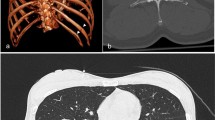Abstract
Introduction
Whole body computed tomography has become standard practice in many centres in the management of severely injured trauma patients, however, the evidence for it’s diagnostic accuracy is limited.
Aim
To assess the sensitivity of whole body CT in major trauma.
Method
Retrospective review of all patients with injury severity score (ISS) > 15 presenting with blunt trauma to a UK Major Trauma Centre between May 2012 and April 2014. Injuries were classified as per ISS score—1 = head and neck 2 = face 3 = chest 4 = abdomen. The authors reviewed patient’s electronic charts, radiological results; interventional procedure records, discharge letters and outpatient follow up documentation and referenced this with Trauma Audit and Research Network data.
Results
407 patients with ISS > 15 presented to the Trauma centre during May 2012 and April 2014. Of these, 337 (82.8%) had a whole body CT scan. 246 pts were male, 91 were female. 74 (21.9%) were due to a fall from > 2 m, 41 (12.2%) due to a fall from < 2 m, 208 (61.7%) were due to motor vehicle crashes, 1 (0.3%) due to a blast injury, 5 (1.5%) due to blows, and 8 (2.4%) due to crush injuries. Sensitivity for Region 1 was 0.98, Region 2 = 0.98, Region 3 = 0.98 and Region 4 was 0.95. Overall sensitivity was 0.98. 15 injuries (2.4%) were not identified on initial CT (false −ve). These injuries were: colonic perforation = 1, splenic contusion = 1, pneumothorax = 1, liver laceration = 1, intracranial haemorrhage = 1, cerebral contusions = 1, spinal injuries = 7, canal haemorrhage = 1, maxilla fracture = 1.
Conclusion
These results show that whole body CT in trauma has a high sensitivity and a low rate of missed injuries (2.4%). However, our study only evaluated a subgroup of patients with ISS > 15 and further work is required to assess the use of this investigation for all major trauma patients.

Similar content being viewed by others
References
Henning J, Woods K. Management of major trauma. Anaesth Intensive Care Med. 2014;15:405–407.
National Audit Office. Major trauma care in England. London: The Stationery Office; 2010. p. 4.
Hui CM, et al. Radiation dose from initial trauma assessment and resuscitation: review of the literature. Can J Surg. 2009;52(2):147–52.
Fabian TC. Whole body CT in multiple trauma. The Lancet. 2009;373(9673):1408–9.
Huber-Wagner S, et al. Effect of whole body CT during trauma resuscitation on survival: a retrospective, multicentre study. Lancet. 2009;373(9673):1455–1461.
Yeguiayan, et al. Impact of whole body CT on mortality and surgical management of severe blunt trauma. Crit Care. 2012;16:R101.
Rizzo AG, Steinberg SM, Flint LM. Prospective assessment of the value of computed tomography for trauma. J Trauma. 1995;38:338–43.
Salim A, Sangthung B, Martin M, Brown C, Plurad D, Demetriades D. Whole body imaging in blunt multisystem trauma patients without obvious signs of injury. Arch Surg. 2006;141:468–75.
Smith I, Naumann DN, et al. Scanning and war: utility of FAST and CT in the assessment of battlefield abdominal trauma. Ann Surg. 2015;262(2):389–396.
Stengel D, Ottersbach C, Matthes G, Weigeldt M, Grundei S, et al. Accuracy of single-pass whole body computed tomography for detection of injuries in patients with major blunt trauma. CMAJ. 2012;184(8):869–76.
Fakler JKM, Orkun A, Justen C. Retrospective analysis of incidental non-trauma associated findings in severely injured patients identified by whole-body spiral CT scans. Patient Saf Surg. 2014;8:36.
Author information
Authors and Affiliations
Corresponding author
Ethics declarations
Conflict of interest
Susan Yoong, Ravi Kothari and Adam Brooks declare they have no conflict of interest.
Informed consent
For this type of study formal consent is not required.
Human and animal right statement
This article does not contain any studies with human participants or animals performed by any of the authors.
Electronic supplementary material
Below is the link to the electronic supplementary material.
Rights and permissions
About this article
Cite this article
Yoong, S., Kothari, R. & Brooks, A. Assessment of sensitivity of whole body CT for major trauma. Eur J Trauma Emerg Surg 45, 489–492 (2019). https://doi.org/10.1007/s00068-018-0926-7
Received:
Accepted:
Published:
Issue Date:
DOI: https://doi.org/10.1007/s00068-018-0926-7




